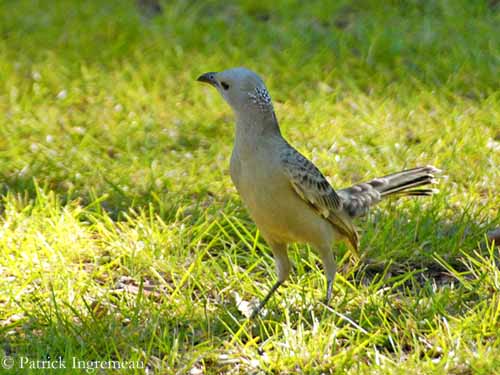
Text by Nicole Bouglouan
Photographers :
Jean Michel Fenerole
Photos d’Oiseaux du monde
Patrick Ingremeau
TAMANDUA
Otto Plantema
Trips around the world
These images and the text are subject to copyright and cannot be used without express authorization from the owners. Legal issues
Sources :
HANDBOOK OF THE BIRDS OF THE WORLD Vol 14 by Josep del Hoyo-Andrew Elliot-David Christie - Lynx Edicions – ISBN: 9788496553507
Birds of Paradise and Bowerbirds De Phil Gregory – Editeur: Bloomsbury Publishing, 2020 – ISBN: 1472975847, 9781472975843 – 416 pages
Les Oiseaux à berceaux - Histoire naturelle et photographies, 262 pages. Michel Ottaviani, (2014). Editions Prin, France. ISBN 978-2-909136-41-7
Birds of the World (family Ptilonorhynchidae)
CREAGUS@Monterey Bay (Don Roberson)
Encyclopedia.com (family Ptilonorhynchidae)
Fat Birder - Bowerbirds & Catbirds (family Ptilonorhynchidae)
Wikipedia, the free encyclopaedia
FAMILY PTILONORHYNCHIDAE
Bowerbirds and Catbirds
The family Ptilonorhynchidae contains 8 genera and 27 species (bowerbirds and catbirds) that are close to the Australasian treecreepers (Climacteridae) and the lyrebirds (Menuridae).
The catbirds of genus Ailuroedus form a distinct subgroup that differs in reproductive behaviour, being monogamous with beparental care, and building directly a bowl-shaped nest where the eggs are laid.
The bowerbirds are polygynous and the female performs alone all the nesting duties. They are known for their special courtship behaviour, with the male building a “bower”, a structure made with sticks and grass, but also a variety of bright-coloured objects, in order to attract a female.
Most species live in rainforests, mossy forests, woodlands, savanna, rocky, wooded gorges and open woodlands to semi-desert in New Guinea and Australia. They feed primarily on fruits, but leaves, nectar and flowers are also part of their diet. During the nesting periods, the young are fed with arthropods, and some small vertebrates such as lizards and frogs may be taken too.
Both catbirds and bowerbirds are threatened by habitat destruction, and especially deforestation. Several species in Australia have declining populations, but numbers and range are large.
They are among the most fascinating birds in the world!

Chlamydera nuchalis
The members of family Ptilonorhynchidae are medium-sized to large-sized passerines, with the Golden Bowerbird (23-25 cm and 62-86 g) and the Great Bowerbird (35-40 cm and 153-215 g). The body shape varies from plump and stocky to slender, depending on the species. The wings are rounded, and like the tail, they are short to medium. The males are usually heavier and slightly larger than the females, and more colourful too, whereas the young birds (juveniles and immatures) have shorter wings and smaller weight than adults and their plumage resembles that of the females.
On the stout, powerful bill, the nostrils are feathered. The Regent Bowerbird has fine and longer bill whereas the Tooth-billed Bowerbird has mostly falcon-like toothed mandibles. The eye’s colour is variable, according to the species. Legs and feet are stout and powerful.
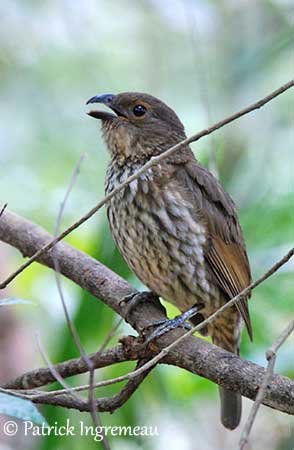
Tooth-billed Bowerbird
Scenopoeetes dentirostris
The plumages are varied, with 50-60 different plumages. The polygynous species show sexual dimorphism and the adult males usually have silky or glossy colourful plumages whereas the females are duller, sometimes with barred underparts. In some species, the male shows an elongate, brightly-coloured erectile crest, but in some others, the short crest is restricted to the nape.
The catbirds male and female of genus Ailuroedus are generally fairly similar, and in some others species like the Tooth-billed Bowerbird, the Vogelkop Bowerbird and the species of genus Chlamydera, both sexes are nearly identical.
The bowerbirds are long-lived species, and the males need five to seven years to acquire the full adult plumage.
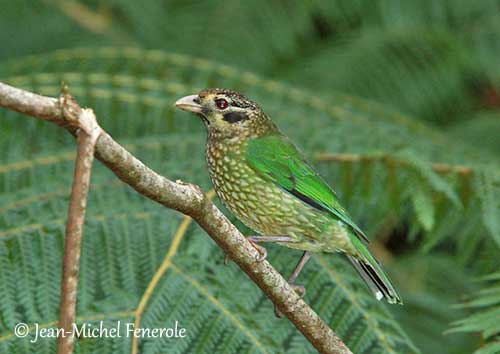
Black-eared Catbird
Ailuroedus melanotis

Vogelkop Bowerbird
Amblyornis inornata
The bowerbirds fly over open areas with strong, undulating flight. During the normal flight, an audible rustling sound is produced by the wings, but some males flying around their bower may produce a loud noise. While foraging, the birds perform a fast, direct flight from the bower or the nest to the feeding trees.
The bowerbirds may forage alone, in pairs or in small groups, but also in flocks. Most species are arboreal and forage in the canopy and in subcanopy foliage, branches and trunks. Some species also feed on the forest floor in the leaf litter.
The arthropods are caught by snatching or sallying, or taken in the air by hawking. However, numerous invertebrates are gleaned from foliage, branches, flowers and leaf-litter on the forest floor.
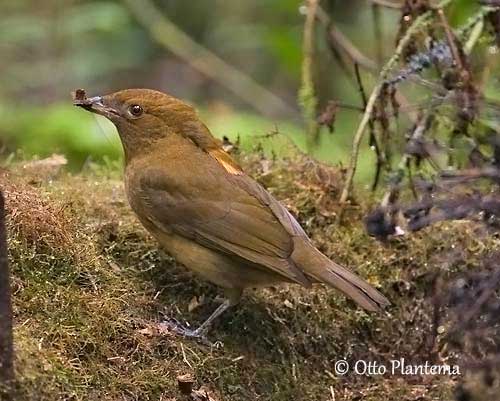
MacGregor's Bowerbird
Amblyornis macgregoriae
But the most interesting behaviour of these birds is observed during the breeding season. However, the catbirds of genus Ailuroedus have different behaviour during this period. They are socially monogamous and the pair-bond may last for one or more years, and both mates breed within a defended territory.
The catbirds have simple courtship displays with the male hopping back and forth between perches with food in the bill. They don’t have court or bower but the female builds a large, deep, cup-shaped structure made with sticks and dry and green leaves, several metres above the ground in tree or climbing vines. The male does not take part in nesting duties, but it usually feed its mate and the chicks.
The female lays 1-2 eggs and incubates during 20-24 days, depending on the species. The young fledge 17-23 days after hatching.
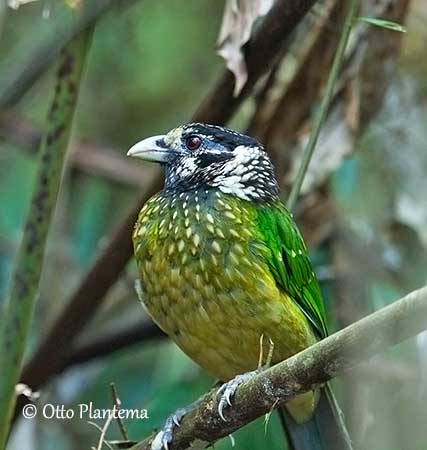
Spotted Catbird
Ailuroedus maculosus
The catbirds and the Tooth-billed Bowerbird are the basal members of this family. But the Tooth-billed Bowerbird of genus Scenopoeetes has different breeding behaviour. It is polygynous and uses a court to attract a female. It cleans and decorates the court by placing leaves on an oval or circular site of about 1-8 m². There are some trees for the displays. During the season, it adds more leaves, always with the pale underside visible.
The sites of several Tooth-billed Bowerbirds are usually clumped together, and the site placed at the heart of this aggregation is probably that of older or more dominant male.
The displays show the male hopping sideways while moving both wings and tail, hiding behind a display tree trunk and uttering “tuck-tic” notes. The entire courtship, from vocal to visual displays, usually takes less than 80 seconds. The copulation is aggressive.
The nest is built by the female, a cup made with sticks between 8 and 27 metres above the ground in dense vine tangle. She lays 1-2 eggs. She performs distraction displays if an intruder or a predator approaches the nest. No more information.
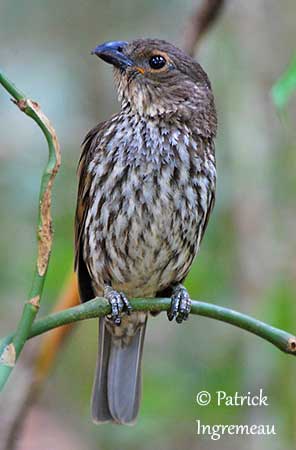
Tooth-billed Bowerbird
Scenopoeetes dentirostris
Among the bowerbirds, the species of genera Amblyornis, Archboldia and Prionodura are named gardener bowerbirds. They build some of the most remarkable structures in the avian world named maypole-type bowers. There are three basic maypole-types.
We can find first a simple tower of sticks, usually built by Golden, MacGregor’s and Golden-fronted Bowerbirds and some populations of the Vogelkop Bowerbird.
The bower of the latter species is a hut-like type and the mat is decorated with fruit, fungi and some human debris sorted into piles according to size and colour.
The male Vogelkop Bowerbird often favours blue, black and orange items. The abundance of decorations varies from one bower to another and helps the females to select a male. Males usually steal items from each other and may destroy some bowers too.
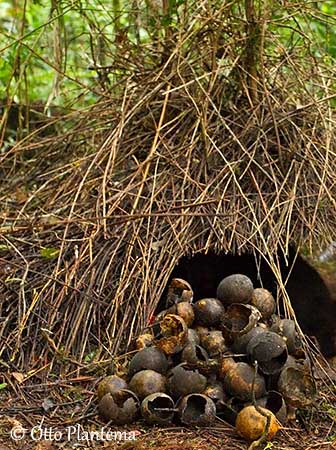
Amblyornis inornata
The Streaked Bowerbird and some other populations of the Vogelkop Bowerbird build a roofed tower of sticks. The Streaked Bowerbird decorates a complex, tepee-shaped maypole bower, with back and side walls, and semi-circular passage around the maypole column, and entrances on either side, facing the front. Several items are used as ornaments including flowers, fruits, fungi, lichens, various insect debris, feathers and bones.
The third basic type is the dispersed maypole of the Archbold’s Bowerbird. There is a cleared area on which an amorphous mat of fern fronds is gradually built. This construction may become more than two metres deep and several square metres in extent. The branches are decorated with orchid stems, but the usual display perches are left bare. The orchid stems may remain alive for long time and some may be in flower. These mats are renovated by the males over several years and can persist for more than 15 years.
The bower of the Golden Bowerbird consists of one or two tall stick towers, often terrestrial, but also uncommonly arboreal. Sometimes, the bower may perch up to two metres above the ground.
Traditional maypole bowers are renovated seasonally (usually at the beginning of the breeding period) and can persist for more than 20 years.
The members of genera Sericulus and Ptilonorhynchus are known as avenue-bower-building silky bowerbirds. These birds have glossy, silky plumage. An avenue-bower is made of two walls of sticks or grass stems, placed parallel to each other and nearly vertically. There is a foundation made with sticks and/or grasses laid on the ground.
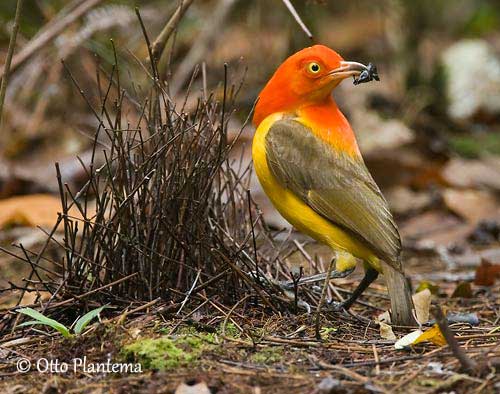
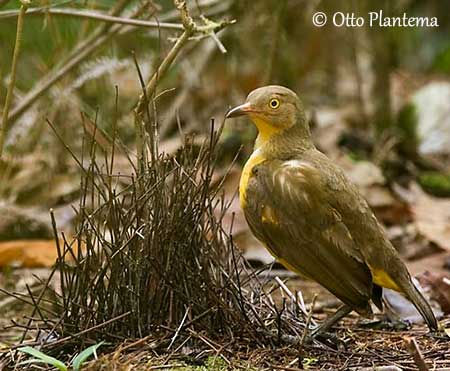
Sericulus ardens
The silky Sericulus species build small, frail and sparsely decorated avenues, whereas the species of genus Ptilonorhynchus build much larger, stronger and more decorated avenues.
The Masked Bowerbird builds a neat, simple avenue-bower decorated with up to six blue or purple fruits, black fungus, snail shells, and yellow to bronze leaves.
The Satin Bowerbird uses primarily blue decorations like its plumage, and 200 or more items may be placed on the platform outside one or both avenue entrances. It may use flowers, snail shells, insect parts and pieces of snakeskin, feathers, but also blue man-made objects when the bower is close to human settlements. Following various displays including buzzing accompanied by body and wing movements performed inside the bower walls, the copulation occurs.
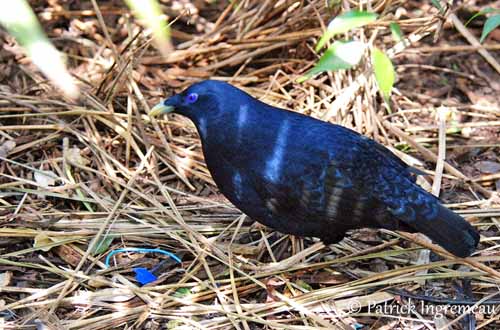
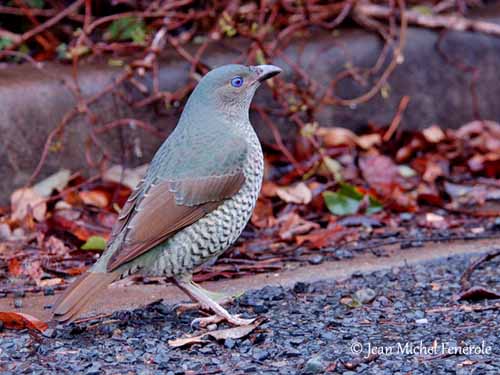
Ptilonorhynchus violaceus
The birds of the genus Chlamydera are named avenue-bower-building grey bowerbirds. These species have duller plumage than other bowerbirds, some of them with erectile filamentous nuchal crest.
The Great Bowerbird uses snail shells and vertebrate bones to decorate its bower, and it may bring them from long distance. In several bowers near Darwin in Australia, the number of items at each bower varied from 6000 to more than 12,000, usually mainly white or grey and weighing about 40 grams.
The avenue-bowers are 1-2 km apart on traditional sites, used during several years. One of them has been used for more than 70 years. The same bower is usually used in several following years, but the bower may also be rebuilt each season, often in the same area.
The walled-avenue of the bower is made with stout sticks on a substantial platform. A single wall may include 700/920 sticks. The tops of the curved central inner walls meet sometimes until forming a tunnel.
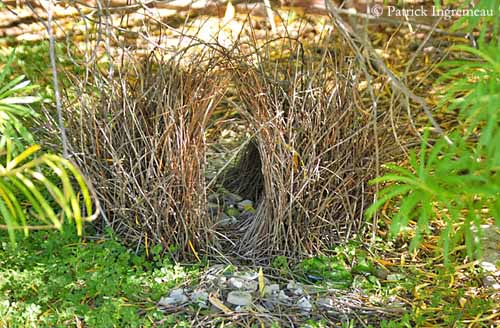
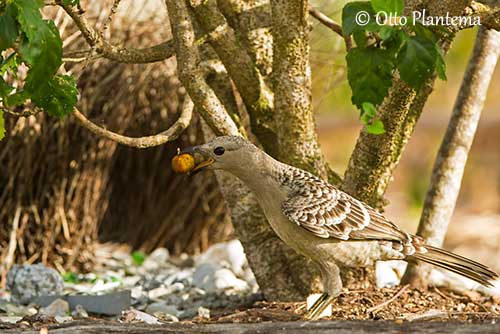
The Fawn-breasted Bowerbird builds a new bower every season, usually close to the previous one. It is decorated with many ornaments such as green fruits often in small bunches, seed pods, flower buds (unopened) and green leaves. But the male also “paints” the inner wall of the avenue. It may use charcoal or vegetation mixed with saliva. These materials dry to a dark powdery deposit. This behaviour is probably a way to assure the females that the bower in actively maintained.
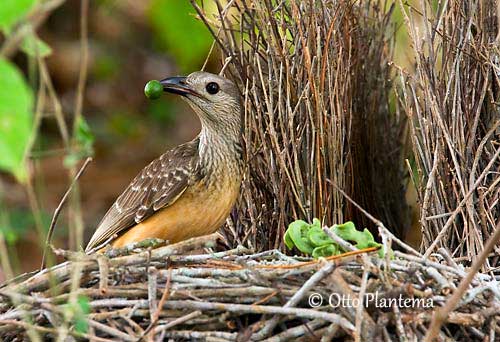
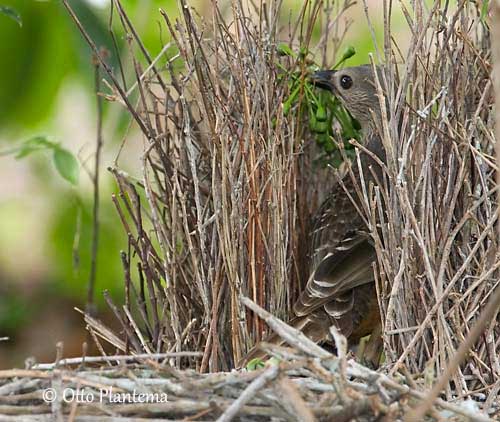
Fawn-breasted Bowerbird
Chlamydera cerviniventris
Adding some green fruit
Fawn-breasted Bowerbird
Chlamydera cerviniventris
Inside the bower
The bowers may differ depending on the species. The Lauterbach’s Bowerbird or Yellow-breasted Bowerbird is the only one in having four walls creating cross passages at right angles. The bower is decorated with grey and blue-grey items such as river pebbles, large blue fruits and medium-sized red fruits. The male spends a long time painting the walls.
The bower is very important and valuable to the owners, and they spend hours building and decorating it. The females prefer males with beautiful bowers and displays. The number of decorations and the density of the sticks used in the construction are good predictors of mating success.
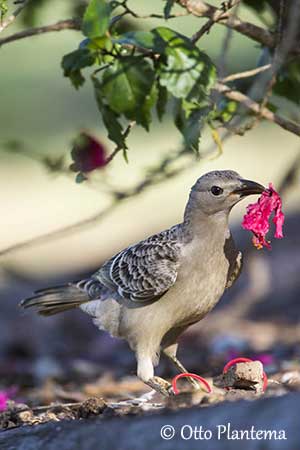
Chlamydera nuchalis
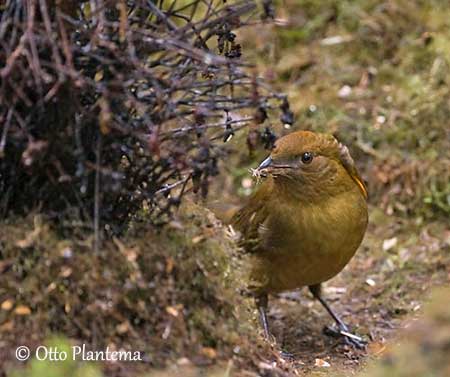
MacGregor's Bowerbird
Amblyornis macgregoriae
The female visits several bowers in order to select a male. She takes up a posture within the bower, while the male performs stereotyped displays, unique for each species. It produces a variety of sounds such as whistles, buzzes and also mechanical sounds, as it is dancing while walking. Some males may pick up and hold ornaments from the bower in the bill during the displays. They bob the head or vigorously toss the items.
When the female is ready to mate, she adopts a crouching posture low in the bower and lifts her tail. The male comes from the rear of the bower and the copulation occurs during just one or two seconds.
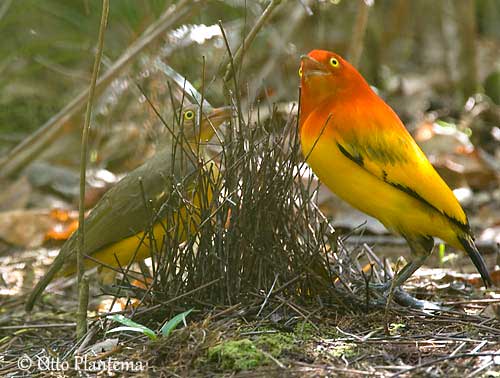
Sericulus ardens
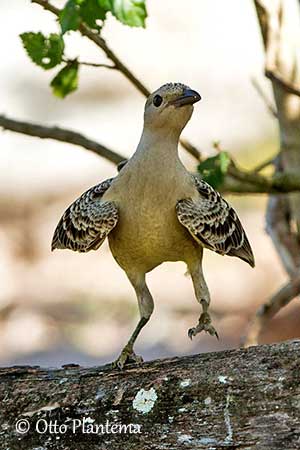
Chlamydera nuchalis
The females of the polygynous species build the nest where the eggs will be laid, and perform alone all the nesting duties. The cup-shaped nests are often built in forks of trees, saplings, bushes and vine tangles. However, the Golden Bowerbird is the only one in building the nest into a tree crevice. The nest-sites are cryptic and situated away from pathways for predators. The clutches of Ptilonorhynchidae comprise one to three eggs and the incubation lasts about 17-21 days, except the Archbold’s Bowerbird with a period of 30 days. They usually produce a single brood per season, but a replacement may occur following the loss of a clutch at the beginning of the season.
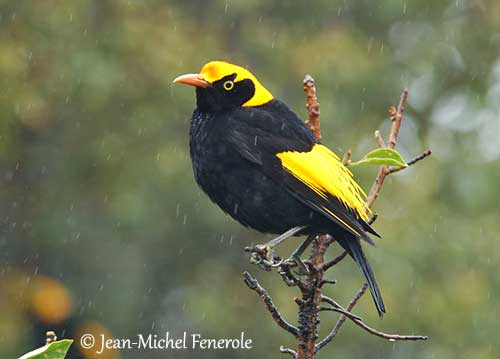
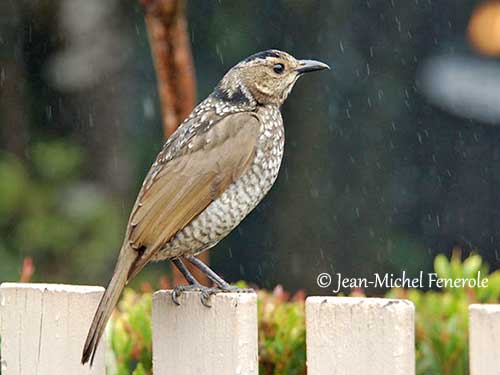
Regent Bowerbird
Sericulus chrysocephalus
Male
Regent Bowerbird
Sericulus chrysocephalus
Female
The bowerbirds have high life expectancy, with individual catbirds living at least 19 years, and males of polygynous bowerbirds for up to 27 years.
Like numerous bird species, the bowerbirds are threatened by destruction of the habitat, involving the decline of the populations, both in Australia and New Guinea. In addition, the spread of domestic and feral cats and other exotic vertebrates through New Guinea is a threat for these birds.
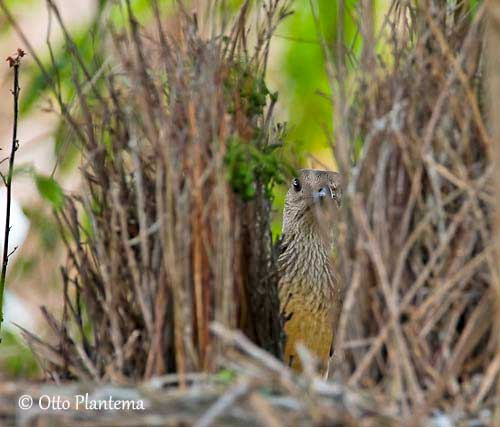
Fawn-breasted Bowerbird
Chlamydera cerviniventris
Both Archbold’s Bowerbird and Fire-maned Bowerbird occur at high elevations where they frequent the wet forest on New Guinea which suffers heavy deforestation. They are respectively listed as Near Threatened and Vulnerable.
Several Australian species have declined due to destruction of the habitat, but their populations are large in a wide range and most of them are evaluated as Least Concern.
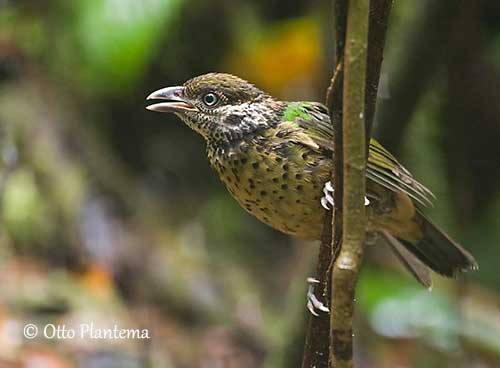
White-eared catbird
Ailuroedus buccoides